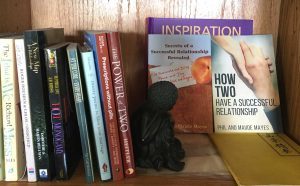Maude Mayes's Blog: Secrets of a Successful Relationship Revealed, page 68
April 17, 2019
Successful Relationships Reading Corner
This week we blogged about total acceptance. Here are a few articles that discuss different aspects of this topic.
Is ‘Radical Acceptance’ the Key to a Lasting Relationship? “I had been perpetuating the turmoil in our relationship by continuing to focus on Sanjay’s flaws. Instead, I needed to accept him as he was and commit to loving him. I needed to fully accept myself as well and not let the fear of rejection prevent me from being open and honest with my feelings.”
7 Ways to Be More Accepting of Your Partner—and Build a Stronger Relationship “The best relationships involve two individuals who feel they can function independently of one another. When one half of a partnership tries to control the other, the results can be disastrous for both sides. A healthy relationship includes trust, and an ability to let the other person be fully themselves, while also fully accepting and loving them.”
9 Differences Between Accepting & Tolerating Your Partner “Regarding romantic relationships, you may accept certain traits about your partner while only tolerating others. Of course, it helps to understand the differences between accepting and tolerating your partner in order to make the differentiation. ‘When we tolerate behavior, we are still angry, frustrated and resentful about it,’ Kim Olver, MS, LCPC, NCC, BCC, founder of The Relationship Center, and author of Secrets of Happy Couples, tells Bustle. ‘However, when we get to acceptance, all the negativity falls away — there is no frustration, anger, or resentment.'”
April 14, 2019
Why You Need Unconditional Acceptance in Your Relationship
 PHIL: How many couples do you know who criticize each other? Try to control the other? Try to change the other? Nearly everyone behaves like this at times.
PHIL: How many couples do you know who criticize each other? Try to control the other? Try to change the other? Nearly everyone behaves like this at times.
But it doesn’t have to be that way. Imagine making no demands on the other. That means none. At all. Ever.
That might seem an impossible, unrealistic goal. Suppose they do something you don’t like? Well, you could attempt to change their behavior. Right here, we have conflict, and the end result isn’t good – either you get your way, but they feel criticized, attacked, controlled, or you lose and feel frustrated and defeated, while they await the next attack.
I’m not suggesting that the only alternative is nothing. You can state how you feel or what you want without making it a demand, explicit or implicit, on the other. “I’m feeling cold” is different from “Close that window.” The former is a revealing of your self, an opening up; the latter is an attempt to bend others to your will.
Now turn this around and imagine that your partner makes no demands on you. Ever. You can go to the pub without snide comments. You can leave the washing-up until the morning. You can pass on visiting the in-laws. Imagine, once you get used to it, how liberating it would be. I liken the normal state of affairs to dancing barefoot in a room with thumbtacks on the floor. Even though there be ever so few, you cannot dance freely, but once you learn and come to trust there are no tacks, you can soar as never before.
This mutuality of permission is, of course, the golden rule, do as you would be done by. You might hesitate at embarking on this, fearing either that if you can never make demands on your partner, they will do unacceptable things, or that if you never react defensively, your partner may take advantage of you.
Quite possible. They may behave in a way that you can never accept – lying, being financially irresponsible, cheating – and obviously, there is no future there, no matter how good the makeup sex is. But maybe your partner’s behavior is just that they are merely being themselves, and not doing anything fundamentally unacceptable. Only time and experience can show you which is which.
But once you can accept that your partner’s different behavior is just that – different – then savor that difference and celebrate the variety they bring into your life.
Imagine making no demands on your partner. That means none. At all. Ever #relationships #quote #love
Click To Tweet
MAUDE: We have discovered that unconditional acceptance of your partner is a baseline for a peaceful relationship. Being treated with total acceptance calls forth a markedly different response in most all of us. When you know that you are not going to be attacked or criticized, an amazing feeling of true peace and calm settles within you and you feel free to be who you truly are and to share this within the relationship, without any fear of reprisals or rejection. Your interactions are not based on power, seeking attention, wanting to be right, or needing to have things only the way you envision them. Instead, you can be open to explore in a way that is only available when full acceptance exists.
We are really talking about what we call the 100% factor. There is no comparison between 100% and 98%. This is similar to two different ways that people try to stop smoking. In one situation, a person decides they have stopped smoking. Any time the urge to smoke comes up, they think to themselves, “No, I won’t be doing that because I already stopped smoking. I don’t do that anymore.” Simple – no decision to be made – it’s already been made – onto the next thing! The other person craves a cigarette and thinks “Well, maybe I’ll just have one. Maybe I’ll just have two a day and slowly stop. Maybe I’ll stop tomorrow.” This person has to make a fresh decision each time the thought comes up. Who do you think actually stops smoking?
Similarly, total acceptance must be total to actually work. To come to a place where you can accept your partner and their actions totally, you have to have a clear baseline of matching core values. Once this is the case, then all else is off limits. It is trespassing on the unique expression of that other person, your partner.
This does not mean that you should not communicate honestly about your feelings and needs. You can always share, speaking in the “I” about those, and you should. Just be clear that this is really about you and not your partner, and do not express things in a blaming or accusatory manner. Don’t try to change your partner because you are already matching in all the things that truly matter to you. Enjoy the differences, and if you stumble on something that keeps nagging at you, share honestly. But remember, your reactions are about you, not your partner.
Honesty is critical to a flourishing relationship and is a prerequisite of total acceptance. You must trust your partner and believe that you both have each other’s interests and happiness in mind and in intention.
Once you reach the acceptance threshold of 100%, your mind is not busy with whether the person is right or wrong, or needs changing or adjusting. Instead, when you accept yourself and the other and go forward in the freedom that this way of being brings, it creates an exquisite experience of peace and joy.
April 10, 2019
Successful Relationships Reading Corner
This week we blogged on the truth of the “we” at the core of relationships. Here are some fascinating articles sharing studies about the use of “we” versus “I” in relationships.
How to Improve Your Relationship With One Simple Word “… check this out: Researcher Robert Levenson and colleagues at University of California, Berkeley, have been eavesdropping on our relationships and found couples who use the word “we” when talking, especially about difficult things, are happier, calmer, exhibit more positive emotional behavior, have less negative automatic arousal (i.e. heart pumping adrenaline and anxiety) and in general are more satisfied with their relationships (think: affection, respect, intimacy) than couples whose communication is more populated by the pronouns you, me and I. ”
“We” vs. “Me” Couples “The ‘we’ couples take themselves less seriously. They don’t imagine they can be perfect and are unsurprised when things don’t go swimmingly. Rather than a ‘here we go again, the universe hates me,’ when the car is stolen, a ‘we’ couple will quickly bemoan the fact that this happened to ‘us’ and move on. Of course cars get stolen, it happens every day. He files the police report, she arranges a rental. They get to work on time and the flow of life continues. ‘Me’ couples blame each other (I told you we shouldn’t have parked here. Why did you open an account in a bank here? It’s a crummy neighborhood). They storm off, they don’t resolve the issue quickly, they don’t get to work and they have more problems as the newest spiral downward commences.”
Love’s Language: Couples who say ‘we’ happier “Previous studies have indicated that use of inclusive pronouns that include ‘we,’ ‘our’ and ‘us’ — versus ‘I,’ ‘me’ and ‘you’ — are evidence of marital satisfaction in younger couples like Sievwright and hubby Dane, both of whom are 27. The latest work, in the September issue of the journal Psychology and Aging, carries the link forward to more established pairs when conflict bubbles, and reports evidence of more relaxed heart rates and blood pressure among those with the highest ‘we-ness’ quotients. ‘We found more ‘we’ language in older couples and in happier couples,’ said Robert Levenson, the study’s senior researcher at the University of California, Berkeley.”
April 7, 2019
The Truth of the “We” at the Core of Relationships
 A core aspect of our relationship is the “We”. And yet we are each separate individuals.
A core aspect of our relationship is the “We”. And yet we are each separate individuals.
Herein lies a paradox we referred to in last week’s blog about seeing differences as an asset. As well as making the “we” central in our relationship, to be an unquestioned baseline, it is also necessary for us to have the knowledge and experience that we are honored, respected and supported unique individuals. This allows us to be free of the need to defend ourselves or our position when discussing things or coming to solutions.
When we can relax in the knowledge that we are seen and heard, and even celebrated for our difference, then we do not experience me against you, but rather us. This is not just an idea or an intellectual understanding. It is a visceral reality that permeates our relationship with a sense of connection to each other, of the palpable love we live with each other.
This sense of loving connection and peaceful goodwill toward one another comes from our basic matching core values. We are both motivated toward fairness and desire for the good of each other, as well as a deep desire to grow as individuals.
Sometimes differences are of no consequence. One of us may want to go to a dance recital and the other is totally uninterested. If one person wants to play golf, but the other doesn’t know how and has no interest in learning, no problem: tell them to tee off. Such freedoms are fine with both of us. We are both happy to be separate and different.
It’s when a problem involves two people – how to make the mortgage payment or handle a recalcitrant child – that it becomes challenging.
The “We” is at the core of our relationship #quote #relationship #marriage #PhilAndMaude
Click To Tweet
Our experience has consistently been that by exploring how we feel about the problem and by hearing the other’s feelings and ideas, we are not only telling each other what is of meaning to us, but we hear ourselves and come to understand our own voice better as well.
This can happen because of the safe arena of communication created by our joint understanding of the “we”. As a result, we know there is always a possibility where we can both agree, and it is our mutual goal to find that together.
Like Rubik’s Cube or a crossword or a corn maze, there will be frustrations en route to the solution, but as long as we are not attached to the idea of being right, these become a challenge, rather than a problem.
Magically, we always find our way to a solution that both of us feel good about because our core values match. It’s always new, something that neither of us was able to imagine at the beginning; we have created it together through our sharing.
The point we want to make here is that throughout this process, we have retained the sense of us, and so resolving the difference has been a puzzle, not a struggle.
You may have a different way of finding this “we” and defining it for each other. The important thing is to find it and to make it an unquestioned given in your relationship. This underlying understanding of that mutuality will lead you to find harmony together and will support you through all of life’s challenges. This is a key to living love. This is a key to peace.
April 3, 2019
Successful Relationships Reading Corner
In this week’s blog, we wrote about seeing differences as an asset in your relationship. Since ours is a very uncommon point of view, we didn’t find articles talking to precisely what we shared, but these all offer useful information about differences in relationships.
Want a Lasting Marriage? Personality Match May Not Matter “Men and women in relationships need not be similar in personality in order to have a successful long-lasting marriage, a new study suggests. The study, which included couples who had been married for at least 40 years, found that neither personality similarities nor differences appeared to affect how happy the couples were.”
Do Your Personality Traits Affect Your Relationship? “So in your relationship is it a matter of “opposites attract” or “birds of a feather”? The question of whether similar or dissimilar personality traits are a source of romantic attraction and marital satisfaction has been debated for years.”
Why Partners Need Complementary Strengths “Your partnerships work on the same principle [of combination]. The best happen when you and someone who has strengths that complement yours join forces and focus on a single goal. Your strengths cancel out your partner’s weaknesses, and vice versa. You accomplish together what could not be done separately. Before you can forge a successful alliance, you must understand what you bring to the combination, and equally important, what you don’t.”
March 31, 2019
See Differences as an Asset in Your Relationship
 Do you want a relationship founded in peace and dedicated to the highest good for both of you?
Do you want a relationship founded in peace and dedicated to the highest good for both of you?
Most of us do. So what goes into having that?
There are some underlying principles that are part of any truly peaceful relationship. One of the most basic is the relation of individuality and union.
Learn to recognize, honor and accept the fact that your partner is an entirely different and unique individual. They are never going to be you, nor think, say or do things exactly the way you do. These differences between you are not a threat, because they arise from the same core values. You are being offered alternative ways of seeing things, of doing things, of feeling things.
When both people recognize and accept this, a wonderful peace occurs, and the energy that might have gone into struggle is instead available for other parts of life.
That is wonderful enough in itself, but there is another aspect that is an additional source of joy, and that is the very difference of the other person. Because both you and your partner can open up without risk, you can both reveal yourselves completely. The experience of being offered another person unedited, unconcealed, is an honor.
It invites the same in return, and a mutual exploration takes place which can feel as if two souls have merged, as if for a time, you inhabit the same room. It invites you to dig deeper and deeper within yourself, finding and sharing aspects that you had lost or buried or never knew, and your partner’s revealed self adds to your world and reflects it and you emerge nourished by contact with another that is a very different experience from self-reflection.
Recognize your partner as a different and unique individual. #quote #relationships #marriage #love
Click To Tweet
This is one of the paradoxes in a successful relationship. Your perspective grows to include both the separateness and difference, while opening to the sublime experience of union.
For us, this has been one of the richest parts of being in a long-term relationship. As we grew to accept each other totally and trust that we would not be attacked, judged, or manipulated, a deep sense of freedom and relaxation permeated our togetherness. With this came an ability to share our feelings, thoughts and needs openly and honestly.
The extraordinary experience of truly getting to know the inner being of another has been transforming. It enriches our perspective on the possible, enhances our understanding of viewpoint and adds an unexpected depth to all interactions. The more we experience this kind of sharing, the deeper our ability to relate to each other, but also to all others, becomes.
This is something that can be done in your relationship, and it can be brought into it at any time if both parties are willing. This kind of total acceptance has to be verbally acknowledged as well as purposefully practiced. It starts with the understanding of the unique nature of your partner. Support that uniqueness. Foster its growth. Through a union based on the understanding of separateness, you can bring out each other’s best potential and help that become a reality.
We’d like to close with one of our favorite quotations on this subject:
Once the realization is accepted that even between the closest human beings infinite distances continue, a wonderful living side by side can grow, if they succeed in loving the distance between them which makes it possible for each to see the other whole against the sky. Rainer Maria Rilke
March 27, 2019
Successful Relationships Reading Corner
In this week’s blog, we wrote about reaching for mutual solutions in your relationship. No one else seems to be talking about this concept, and the closest we could find was articles talking about problem-solving and decision-making.
The Art of Solving Relationship Problems “Unsettled problems are a major source of stress, stress that can not only undermine your relationship, but your diabetes management as well. Research has shown that successful relationships are not those that necessarily have fewer problems, but those that have found effective means of solving the problems that come up. Here is a 6-step process for tackling and solving those problems in your relationships.”
Learning to Make Joint Decisions “Learning to make joint decisions is an important part of any long-term romantic relationship. While decisions start small, with tonight’s supper, they get bigger, through the colour of the bathroom to whether to have children, how to manage childcare, and whether to move abroad to support one partner’s career, for example. Developing a reliable basis for decision-making and discussion will provide a good foundation for a long-lasting relationship.”
7 Solutions That Can Save a Relationship “Even though every relationship has its ups and downs, successful couples have learned how to manage the bumps and keep their love life going, says marriage and family therapist Mitch Temple, author of The Marriage Turnaround. They hang in there, tackle problems, and learn how to work through the complex issues of everyday life.”
March 24, 2019
Reach for Mutual Solutions in Your Relationship
 Find your answers by co-creating them!
Find your answers by co-creating them!
One of the reasons we get on so well is that when we tackle a problem, whether emotional or practical, we are adept at finding a mutual solution, an outcome that works for both of us. It is something that we have created together by contributing our different viewpoints. It is not something that either of us would have come up with alone because each of us brings different knowledge, views and insights to bear.
Because each of us is attempting to construct something that both works for ourselves and addresses the concerns of the other, we end up with a solution that works for both of us and does not involve compromise. This is possible because, in any situation, there are multiple possibilities, but at the start, we can usually only see one.
Compromise is the act of giving up something to get something else. It assumes that there are different sides, and that one must settle in order to avoid conflict. It does not allow for the possibility that a resolution can be found, a resolution where, instead of giving up or changing something, you can create a solution that was not originally imaginable to either person. Without putting down compromise or its benefits, we are discussing a different path– one that is not about giving up on some part of yourself, your wants and perhaps even needs, but rather a path that, by acting in union, allows you to find new mutual solutions. How Two: Have a Successful Relationship
We have examined how we go about this and identified a method for creating mutual solutions and incorporating this into your relationship. We call this Our Process (read about it here or listen to Phil reading it to you). This process can be applied by any two people who wish to experience peace together, and intend to share decisions and plans from a place of true mutuality. Here is a summary of it from our latest book.
A willingness to change and a belief that other positions are possible are both critical to this process. Our intention is to be together and to reach a solution or decision that is mutual. We are both fully present with each other, and neither of us has a predetermined answer. By hearing each other and being open, new ideas arise, and for each of us, our landscape of possibilities expands until we meet at a solution that neither of us imagined at the start. A new creation has emerged; something that is the product of both of us together, rather than from just one of us alone. How Two: Have a Successful Relationship
Our blog last week was on active listening, an integral part of Our Process. Whatever methods you use to reach a mutual solution, the magical thing is that, in a committed relationship based on a secure foundation, one is always to be found. If this hasn’t been your experience to date, then it’s time to revise your expectations. Talk with your partner and see if you can both move past the assumptions of win-lose and compromise and aim for a mutual solution. The magic is that there is always a rabbit in the hat, even though you both swore it was empty.
In summary, a mutual solution is
Something new that arises from each of you working together.
Something that neither of you would have come up with alone.
Something that works for both of you because it is a product of the two of you.
March 20, 2019
Successful Relationships Reading Corner
In this week’s blog, we wrote about the need to balance talking and listening. We didn’t find any discussions about this balance, but here are some good links on active listening.
Active Listening: The Art of Empathetic Conversation “It is time to focus again and practise the skill of mindful listening. Not just because we owe our full attention to others when we converse, but because the positive emotions of a truly good conversation have the potential to make us happy!”
Active Listening: The Master Key to Effective Communication “The sense that we are not being listened to is one of the most frustrating feelings imaginable. Toddlers scream about it, teenagers move out, couples split up, companies breakdown. One of the main reasons this breakdown in communication occurs is that listening (like reading, thinking clearly and focusing) is a skill which we rarely consider to be something requiring knowledge and practice.”
How to Listen and Build Deeper Connections with People “We’ve never had more excuses to not listen. As technology advances and content explodes, we continue to spread our attention across multiple screens, problems, and people — often all at once. As a result, attention has become one of the scarcest resources — and one of the most valuable. People who can truly listen have a unique edge in a world fragmented by distraction.”
March 17, 2019
You Need to Balance Talking and Listening
 There’s more to active listening than usually gets discussed.
There’s more to active listening than usually gets discussed.
We bumped up against this recently, while working on a Secret Project. We were talking, and both of us felt interrupted by the other. We’ve occasionally had this experience of being interrupted by the other person before completing the point we were trying to make. We’ve objected, pushed to complete the idea, then moved on. These events haven’t left scars because we don’t work like that, but we have become sensitive to such interruptions.
Since we know so deeply that we want the same things, and neither of us is interested in combative exchanges, we stopped the discussion and turned our process on the experience we were having instead.
We both understand and practice active listening with each other, so what was going on? What we turned up in our processing are some aspects of active listening and hearing each other, that are not often considered.
There are of course different kinds of exchanges and they call for different behaviors.
Wanting to be Heard
Phil was in a relationship where his partner would tell of her troubles and he would respond with suggestions, but that wasn’t really what was needed. Instead, she wanted to express her feelings, and who wants their feelings to be cut short in the middle? The goal is to be heard, not to get anything fixed or even commented upon. This is a common male-female dynamic, as men see themselves as (or have been cast as) fixers and problem solvers.
When this pattern arises, both people can contribute to fixing it. When listening, be sensitive to the needs of your partner, but as the speaker, be explicit about your needs. Share right up front what you are and aren’t looking for. This saves much frustration and gets you the kind of attention and listening you need.
Brainstorming
This is a jamming session where you are sharing free-flowing ideas, and you both just throw them out (usually writing them down to cull later) with no discussion or reaction. The goal in this type of exchange is to get as many ideas down from both of you as you can, so you have a large creative field from which to further develop something. In this style of sharing there is no real active listening called for (except as it stimulates more ideas) as you are both just adding as many diverse concepts as you can.
Exchanging Ideas
We have written about the importance of active listening – of paying attention to what the other person is saying, rather than working on preparing a response. As we have written, “Actually listen, rather than waiting for the moment when you can talk again about why your opinion is the correct one.”
Although this is ideal, the reality is that responses and ideas come up as the other person is speaking and it can be a considerable effort to both hold on to those thoughts and continue to follow the speaker. We all know what that feels like, and how much less we hear of what our partner says when we are holding on to our thoughts and waiting our turn to speak them.
And yet, how can we avoid this situation? When we are actively seeking solutions, decisions or plans, we are excited. We get ideas from listening that are compelling and important to say. How do we keep the exchange going, and not step out of the important process of hearing our partner, while still being able to share the ideas as they come forth?
Stay connected! Stay aware of each other!
Sound simple? It is once you become aware of it, and yet it is so infrequently practiced. We tend to stay in our own minds when describing a thought or idea. We pay less attention to our partner when we are the speaker. Active listening must have both sides – speaker and listener – aware of each other at all times. Sense if your partner has something to say that fits in, and interrupt your speaking or cut short the length to allow their thoughts to enter. Both parties have to find a balance between expression and reception. Both parties have equal roles in maintaining this balance.
Who cares what the resolution is if you both feel separated or estranged at the end of it? Remain aware that this is a process the two of you are sharing – you are going somewhere together. The most important part of the discussion is the experience you are having together, not the end result. When you have this kind of experience, it is such a delicious pleasure, that it will produce answers born of this closeness.
When practicing active listening, stay connected! Stay aware of each other! #relationships #quote
Click To Tweet
Just the act of staying aware of each other and remaining connected through it all will completely change the dynamic. Remember, have fun with your interactions. After all, the real purpose is to find mutuality, to feel connected, heard, seen and loved.
Notes
1. Cultural differences can play into this. For example, Deborah Tannen writes “many Californians expect shorter pauses than many midwesterners or New Englanders, so in conversations between them, the Californians end up interrupting.” (Her book on language differences is a must-read.)
2. When talking, we (Maude and Phil) usually sit side by side with our forearms touching. It feels as though this way, a significant amount of communication occurs non-verbally.
Secrets of a Successful Relationship Revealed
We use this blog to continue the exploration of the magic that can be found in a relationship, and the wider implications of peace for the world. ...more
- Maude Mayes's profile
- 8 followers




